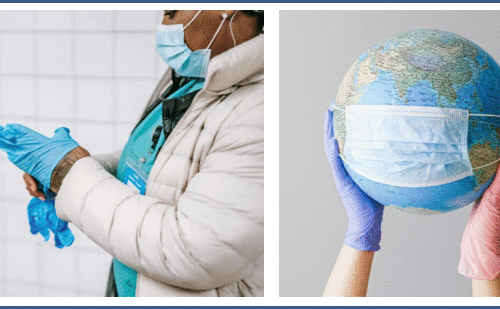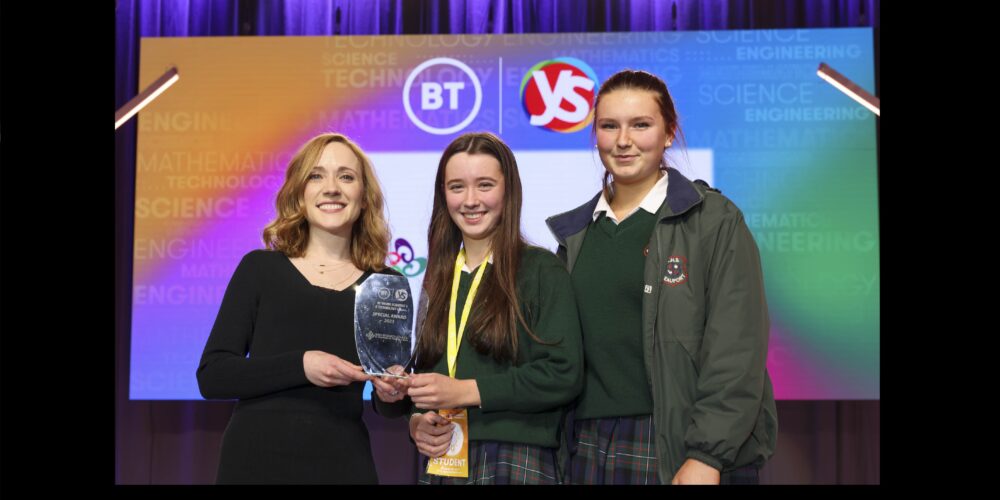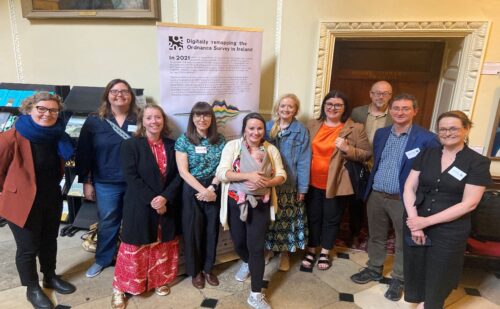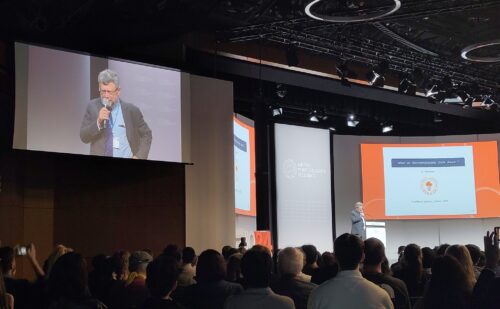

Sophie Brennan and Ava Clare of Loreto High School Beaufort, Dublin, win IRC Special Award at BT Young Scientist and Technology Exhibition
Posted: 23 February, 2023
The 59th BT Young Scientist and Technology Exhibition was held in the RDS, Ballsbridge, from the 12th-14th January 2023. This year’s event represented the return of the exhibition to an in-person format after two years of remote events due to Covid 19. The overall winners were Shane O’Connor and Liam Carew from The Abbey School in Co. Tipperary, for their project: “Assessing the impact of second-level education on key aspects of adolescents’ life and development”.
The Irish Research Council has been delighted to be a longstanding supporter of the exhibition and is sponsor of a Special Award for the project which best combines two or more branches of science, or a branch of science with branches of the social sciences and humanities. The winning entry in 2023 was a project in the Social and Behavioural Sciences category. Congratulations to the winners, Sophie Brennan and Ava Clare from Loreto High School Beaufort in Dublin! Their project examined the relationship between air temperature trends and water demand as a means for predicting future water usage.
Sophie and Ava told us more about their project ‘Flow Forecast’ and their experience of the BT Young Scientist and Technology Exhibition:
How did you get involved in BTYSTE?
We got involved in the BT Young Scientist Exhibition with help from our Junior Cycle Science teacher, Ms Maloney, and our school’s Vice Principal, Dr Niamh McNally. Both of us have always loved science since we first started studying it in first year, so when we were told about this competition and given the opportunity to enter, we were really excited. As we are currently in fourth year, our school provides an option to pick ‘BTYSE’ as a module. This helped us to work on our project as we chose this module along with 15 other girls. Most of us who entered got into the competition as our school had a total of 7 projects, including one from a third year student.
How did you come up with your idea?
Both our fathers work with water in their jobs. Due to this, we were both already informed about water usage and demand. When we had to come up with a topic, we used this previous knowledge on the subject to create our project. Sophie had already completed a week of work experience in Uisce Éireann which also helped in getting insight in the project. Once we knew what our project was going to be, we had to carry out a large amount of research. Firstly, we found other papers which contained information about the area we were studying. Then, we had to collect data from the Met Éireann and Uisce Éireann websites.
We gathered weather data dating as far back as 1964 and water data dating back as far as 2014. Then, we had to analyse our data to find how people react to air temperature in relation to water demand. We found a relationship between air temperature and the water demand. Using this relationship, we created a method of predicting future water demand based on air temperatures. We did this by using Microsoft excel to create graphs which showed this relationship and then inserting future trend lines into these graphs.

How would you describe the preparation for the exhibition? What were the most challenging aspects?
When making this project we had to collect a lot of data from Met Éireann and Uisce Éireann. We had to complete the research and analysis portion of our project before we were able to put together our report book and poster. Due to the huge amount of data, this part of our preparation took the longest. We found that handling our data was the most challenging part. The poster and report book were much easier to complete as once we had completed our research and analysis, we found that we were able to write about our project easily enough once.
What were the highlights of the exhibition?
When we were at the exhibition there were many highlights. One of the best parts of the exhibition was getting to meet loads of new people from different schools. We got to make friends with people from different counties who we wouldn’t have met if we hadn’t taken part in the exhibition.
Can you see yourselves getting involved in research in life after school? What are your plans, at least, at this point in time?
In the future we both can see ourselves getting involved in research after school. In our school, from fourth year onwards we get career guidance classes every second week. In these classes we look at future college courses and careers. In making this project, and the large amount of research that was involved with it, we learned more about how to accurately research topics. This gave us more of an insight into what research life after school would be like. Since we enjoyed this project, we have both looked more into a possible research life after school during these classes. We wouldn’t have looked into the research aspect of careers as much before this project. Currently, Ava would like to be a barrister or solicitor, and Sophie would like to be an accountant or in finance. We aren’t sure what we would like to do at this point in time as we are only in fourth year but right now those careers are the ones that we are looking into. The research for our project and the project report have prepared us for those aspects of work in any third level course that we decide to take in the future.

